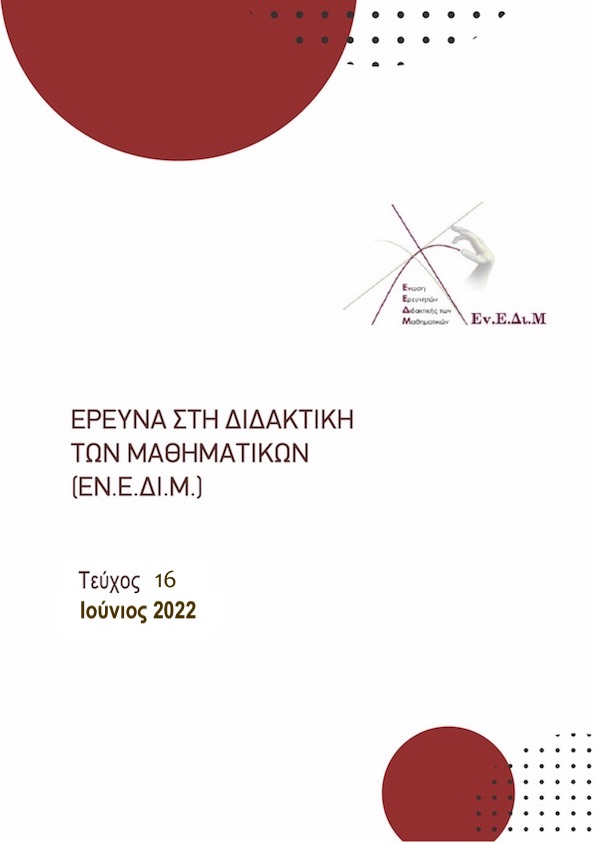ΟΨΕΙΣ ΤΗΣ ΜΑΘΗΜΑΤΙΚΗΣ ΓΝΩΣΗΣ ΓΙΑ ΤΗ ΔΙΔΑΣΚΑΛΙΑ: ΜΙΑ ΕΜΠΕΙΡΙΚΗ ΜΕΛΕΤΗ ΜΕ ΕΚΠΑΙΔΕΥΤΙΚΟΥΣ ΤΗΣ ΔΕΥΤΟΡΟΒΑΘΜΙΑΣ ΕΚΠΑΙΔΕΥΣΗΣ.

Δημοσιευμένα:
Μαΐ 31, 2022
Λέξεις-κλειδιά:
Ρητός αριθμός αρχή του επομένου πυκνότητα Μαθηματική Γνώση για τη Διδασκαλία
Περίληψη
Στην παρούσα εργασία παρουσιάζεται μια εμπειρική μελέτη με στόχο τη διερεύνηση πτυχών της Μαθηματικής Γνώσης για τη Διδασκαλία εκπαιδευτικών της δευτεροβάθμιας εκπαίδευσης. Πραγματοποιήθηκαν ημι-δομημένες συνεντεύξεις με 15 εν ενεργεία εκπαιδευτικούς που κλήθηκαν να αξιολογήσουν απαντήσεις υποθετικών μαθητών σε ερωτήματα σχετικά με την πυκνή διάταξη των ρητών αριθμών, να εξηγήσουν τον τρόπο σκέψης των μαθητών, και να δώσουν ανατροφοδότηση. Τα ευρήματα της έρευνας αναδεικνύουν αδυναμίες όσον αφορά την Κοινή και την Εξειδικευμένη Γνώση του Περιεχομένου, τη Γνώση του Περιεχομένου και των Μαθητών και τη Γνώση του Περιεχομένου και της Διδασκαλίας.
Λεπτομέρειες άρθρου
- Πώς να δημιουργήσετε Αναφορές
-
Αυγέρη Θ. Φ., & Βαμβακούση Ξ. (2022). ΟΨΕΙΣ ΤΗΣ ΜΑΘΗΜΑΤΙΚΗΣ ΓΝΩΣΗΣ ΓΙΑ ΤΗ ΔΙΔΑΣΚΑΛΙΑ: ΜΙΑ ΕΜΠΕΙΡΙΚΗ ΜΕΛΕΤΗ ΜΕ ΕΚΠΑΙΔΕΥΤΙΚΟΥΣ ΤΗΣ ΔΕΥΤΟΡΟΒΑΘΜΙΑΣ ΕΚΠΑΙΔΕΥΣΗΣ. Έρευνα στη Διδακτική των Μαθηματικών, (16), 26–45. ανακτήθηκε από https://ejournals.epublishing.ekt.gr/index.php/enedim/article/view/28087
- Τεύχος
- Αρ. 16 (2022)
- Ενότητα
- Άρθρα

Αυτή η εργασία είναι αδειοδοτημένη υπό το CC Αναφορά Δημιουργού 4.0.
Οι συγγραφείς των άρθρων που δημοσιεύονται στο περιοδικό διατηρούν τα δικαιώματα πνευματικής ιδιοκτησίας επί των άρθρων τους, δίνοντας στο περιοδικό το δικαίωμα της πρώτης δημοσίευσης. Άρθρα που δημοσιεύονται στο περιοδικό διατίθενται με άδεια Creative Commons BY και σύμφωνα με την άδεια μπορούν να χρησιμοποιούνται ελεύθερα, με αναφορά στο/στη συγγραφέα και στην πρώτη δημοσίευση.Λήψεις
Τα δεδομένα λήψης δεν είναι ακόμη διαθέσιμα.
Αναφορές
Ball, D. L., Thames, M. H., & Phelps, G. (2008). Content knowledge for teaching: What makes it special? Journal of Teacher Education, 59(5), 389-407.
Ball, D. L., & Bass, H. (2009, March). With an eye on the mathematical horizon: Knowing mathematics for teaching to learners’ mathematical futures. Keynote address at 43rd Jahrestagung für Didaktik der Mathematik, Germany.
Behr, M.J., Lesh, R., Post, T.R., and Silver, E.A. (1983). Rational number concepts. In R. Lesh and M. Landau (Eds.), Acquisition of Mathematics Concepts and Processes (pp. 91-125). New York: Academic Press.Biza, I., Nardi, E., & Zachariades, T. (2007). Using tasks to explore teacher knowledge in situation-specific contexts. Journal of Mathematics Teacher Education, 10(4), 301-309.
Cheung, P., Rubenson, M., & Barner, D. (2017). To infinity and beyond: Children generalize the successor function to all possible numbers years after learning to count. Cognitive Psychology, 92, 22-36.
Depaepe, F., Verschaffel, L., & Kelchtermans, G. (2013). Pedagogical content knowledge: A systematic review of the way in which the concept has pervaded mathematics educational research. Teaching and Teacher Education, 34, 12-25.
Giannakoulias, E., Souyoul, A., & Zachariades, T. (2007). Students’ thinking about fundamental real numbers properties. In D. Pitta-Pantazi, & G. Philippou (Eds.), Proceedings of the Fifth Congress of the European Society for Research in Mathematics Education ERME, Department of Education, University of Cyprus, Cyprus, (pp. 416–425).
Giannakoulias, E., Mastorides, E., Potari, D., & Zachariades, T. (2010). Studying teachers’ mathematical argumentation in the context of refuting students’ invalid claims. The Journal of Mathematical Behavior, 29(3), 160-168.
Markovitz, Z., & Sowder, J. (1991). Students’ understanding of the relationship between fractions and decimals. Focus on Learning Problems in Mathematics, 13(1), 3–11.
Merenluoto, K., & Lehtinen, E. (2002). Conceptual change in mathematics: Understanding the real numbers. In: M. Limon, & L. Mason (Eds), Reconsidering Conceptual Change: Issues in Theory and Practice (pp. 233–258). Dordrecht, The Netherlands: Kluwer.
Richland, L. E., Holyoak, K. J., & Stigler, J. W. (2004). Analogy use in eighth-grade mathematics classrooms. Cognition and Instruction, 22(1), 37-60.
Peled, I., & Zaslavsky, O. (1997). Counter-examples that (only) prove and counterexamples that (also) explain. FOCUS on Learning Problems in Mathematics, 19(3), 49- 61.
Potari, D., Zachariades, T., & Zaslavsky, O, (2004). Mathematics teachers’ reasoning for refuting students’ invalid claims In V. Durand-Guerrier, S. Soury-Lavergne, &
F. Arzarello (Eds.), Proceedings of the Sixth Congress of the European Society for Research in Mathematics Education (pp. 281-290). Lyon, France: Institut national de recherche pédagogique.
Shulman, L. S. (1986). Those who understand: Knowledge growth in teaching. Educational Researcher, 15(2), 4-14.
Terry, G.; Hayfield, N., Clarke, V. & Braun, C. (2017). Thematic analysis. In C. Willig & W. Stainton Rogers (eds) The Sage Handbook of Qualitative Research in Psychology (pp. 17–37), 2nd ed., London: Sage
Tirosh, D., Fischbein, E., Graeber, A. O., & Wilson, J. W. (1999). Prospective elementary teachers' conceptions of rational numbers Retrieved June 11, 2004, from http://jwilson.coe.uga.edu/texts.folder/tirosh/pros.el.tchrs.html
Vamvakoussi, X., & Vosniadou, S. (2010). How many decimals are there between two fractions? Aspects of secondary school students’ understanding of rational numbers and their notation. Cognition and Instruction, 28(2), 181-209.
Vamvakoussi, X., & Vosniadou, S. (2012). Bridging the gap between the dense and the discrete: The number line and the “rubber line” bridging analogy. Mathematical Thinking and Learning, 14(4), 265-284.
Zazkis, R., & Leikin, R. (2010). Advanced mathematical knowledge in teaching practice: Perceptions of secondary mathematics teachers. Mathematical Thinking and Learning, 12(4), 263-281.
Zaslavsky, O. (2010). The explanatory power of examples in mathematics: Challenges for teaching. In Instructional Explanations in the Disciplines (pp. 107-128). Springer, Boston, MA.
Zaslavsky, O. (2019). There is more to examples than meets the eye: Thinking with and through mathematical examples in different settings. The Journal of Mathematical Behavior, 53, 245-255.
Ζωιτσάκος, Σ. (2019). Μαθηματική γνώση των εκπαιδευτικών για τη διδασκαλία των ανώτερων μαθηματικών στη δευτεροβάθμια εκπαίδευση (Διδακτορική διατριβή, Εθνικό και Καποδιστριακό Πανεπιστήμιο Αθηνών (ΕΚΠΑ). Ανακτήθηκε από: https://www.didaktorika.gr/eadd/handle/10442/46255
Φωκάς, Δ., & Βαμβακούση (υπό δημοσίευση Η κατανόηση της πυκνής διάταξης των ρητών από μαθητές Β΄ Λυκείου: Ένα διδακτικό πείραμα. Ψυχολογία.


